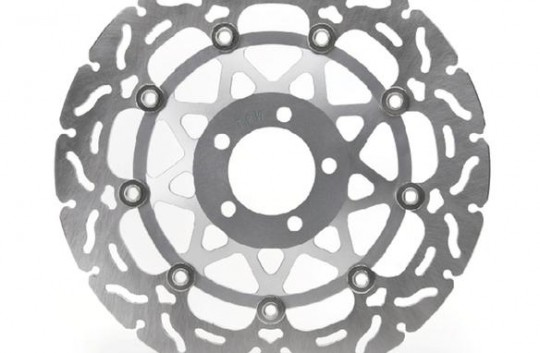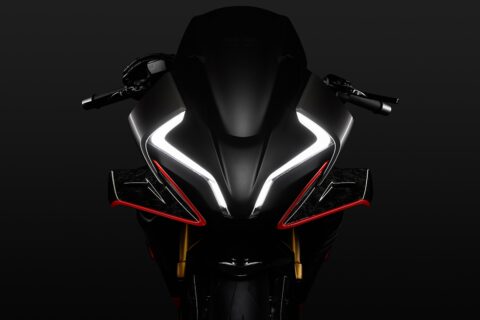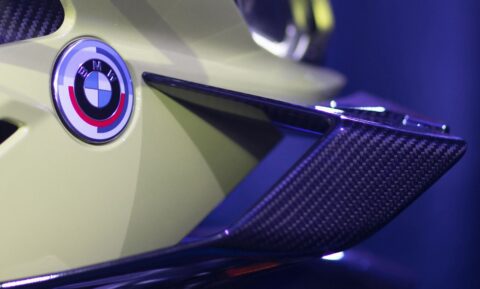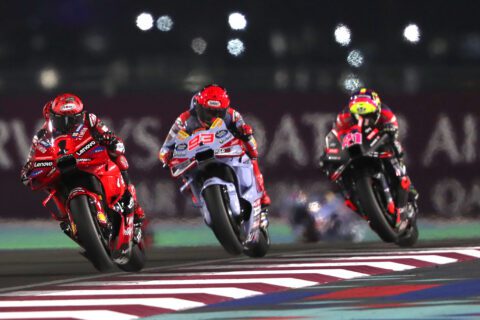Disc brakes may not seem like an impressive topic at first glance, but consider this: assume you’re riding along at just over 30mph when something happens and you need to stop, real fast. You grab the brakes. In a few tenths of a second the forks compress enough that you have good feel for the tyre and can brake as hard as possible.
Bearing in mind you were doing just over 30mph when all this started, we’ll assume for convenience that you’re doing exactly 30mph at the moment you brake as hard as possible. That being the case, you and your bike should be sat perfectly still in the next 1.85 seconds. Thank you disc brakes.
But what would happen if you had the brake pads in your hands and squeezed them onto the disc manually? How long would it take you to stop then? The answer is somewhere in the region of 18-21 seconds depending on whether you have a killer hand shake or not. That’s a massive difference considering how slow the speed was, so what’s going on?
Disc brakes are deceptively simple things. Deceptive because despite the small number of moving parts, they do some really clever stuff. Their job is to convert the bike’s kinetic energy into another form – heat mostly, without affecting the bike’s straight line or cornering performance. But as we’ve seen, the crush force of the human hand is nowhere near strong enough even when squeezing as hard
as possible.
So, disc brake systems make you stronger, and they do this in two ways. The first is with the lever itself. You know loosening a nut is easier with a longer spanner because it gives you a mechanical advantage. With a brake lever, your fingers pull anywhere from 100–200 mm away from the pivot point; and yet the part that actually pushes on the piston inside the master cylinder is generally about 15 mm from the pivot. That instantly multiplies the force you squeeze with by anything from seven to 13 times.
The real advantage is gained through the hydraulic ratio though. A hydraulic ratio is a like the gears on your pushbike, except rather than counting teeth, it counts surface area. Think of it like this; select the small cog on the front of your bike and the biggest on the back and what happens? You don’t go fast, but you can climb really steep hills. It works the same way with hydraulics – a small surface area pushing a big surface area gives you an advantage.
So picture the front master cylinder on your bike. Chances are the piston inside it is about 18 mm across, a fraction smaller than a one-pence piece. Now look at the calipers. Chances are the pistons will be about the same size as a two-pound coin. Of course placing a 1p and £2 coin side by side nicely illustrates the advantage. Except we need to add a £2 for every piston in the system. So on a modern sportsbike, that’s eight £2 coins versus a single 1p coin. In other words a massive advantage that can increase your input force by another 15-25 times.
Do more pistons mean better brakes? It depends. In terms of the hydraulic ratio all the matters is the area of the master cylinder piston compared to the combined area of the slave/caliper pistons, not the number. You could have one massive caliper piston and it would have a much greater ratio than, say, 20 smaller ones. But that massive piston would be heavy, and you’d need a really wide disc area to make use of it, which would affect the handling and probably the bike’s acceleration.
Disc size is equally important to the brake’s effectiveness.
A large disc increases the speed at which the disc moves through the caliper as well as not giving away a size advantage to the tyre. By that I mean distance between the axel and centre of the brake disc is less than the distance between the axle and the contact patch. So whatever torque is generated at the caliper is reduced at the contact patch. But big discs generally have larger moments of inertia.
When it comes to discs it’s not overall weight that matters, but where the weight is carried. For example, you could have two discs that weighed the same. One has a heavy centre and light outside and the other vice versa. The one carrying its weight closer to the centre will be easy to speed up and slow down, as well as feeling more flickable.
The term moment of inertia describes where an objects weight is in relation to its axis of rotation. That’s the reason some bikes have wavy discs and one of the benefits of drilled discs – because it reduces weight at the farthest point from the axle.
Reducing the weight of the disc too much can cause the brake to overheat, because there isn’t enough material to absorb the huge amount of heat generated during heavy braking.
On the other hand, a disc can be shaped in such a way that the surface area is increased, allowing the disc to cool more efficiently. In that case the danger is that so much material is removed there is less metal for the pads to push on in the first place.
In terms of how they actually work there’s nothing to it. Squeezing the lever forces the pistons out of the calipers and presses the pad to the disc. When you release the lever the seals inside the caliper retract the pistons slightly allowing the pad to move away from the disc. The real enemy to brakes is air in the system, flex in the brake lines or splay in the caliper. That’s because any of those things reduce the how effectively the pads are pressed against the disc.
Hello, I’m a fact...
The newton (N) is a unit of force. It’s defined as the force required to accelerate 1 kg at a rate of 1 m/s2. In normal man speak it’s easier to picture what it feels like, so find something with a mass of about 100 grams (an apple for example). The force (weight) you can feel the apple exerting on your hand is what a newton of force feels like.
Hello, I’m a fact...
There’s no right and wrong way to jump on the brakes. For virtually the same lap time, some riders grab a big handful then feather the pressure off, while others build progressively but let the brake off quicker. Typically race bikes generate between four and six bar of brake pressure. Most front wheels lock at around 16 bar of brake pressure.
Hello, I’m a fact...
During hard braking it’s not uncommon for the caliper’s clamp force to reach 7,000 newtons [like having 713 kg pressing on you]. While that seems a lot it pales against the masticatory magnificence of saltwater crocodiles, which according to the internet have a bite force (near the jaw hinge I assume) of 16,400 newtons. That means two saltys biting on your discs at 30 mph would have you stopped in about 0.55 seconds and pulling nearly 2.5 G.
Calculations
An average force of 10 N [newton] (that’s the same force a 1 kg weight exerts) is applied at a point 0.150 m [metre] from the lever’s pivot meaning there is now a torque of 1.5 Nm on the lever. The distance from the brake lever pivot to the point where it acts on the master cylinder’s piston is 0.015 m. The force applied to the piston is therefore 100 N (1.5 Nm / 0.015 m = 100 N).
The master cylinder piston has a radius of 0.009 m, so its surface area is 2.54 x 10-4 m2
(2 x π x 0.0092 m). We know there is a force of 100 N applied to the piston which means the pressure on the brake fluid must be 393,701 Pa [pascals] (100 N / [2.54 x 10-4 m2]). As each piston in the caliper has a radius of 0.015 m, its surface area is 7.07 x 10-4 m2 (2 x π x 0.0152 m). The hydraulic ratio is there for 22.26:1 as there are eight pistons ( 8 x [7.07 x 10-4 m2] / 2.54 x 10-4 m2). As there are two pistons acting on each pad we can work out the force as 557 N (393,701 Pa x [2 x {7.07 x 10-4 m2}]). Two pads oppose each other in a caliper so the clamping force is actually 1,114 N (2 x 557 N) per caliper.
Now we know the clamping for each caliper we can work out the braking torque at the disc. Assuming the pads have a coefficient of friction of 0.4, the force acting on each disc is 445.6 N (1,114 N x 0.4).
If the discs have a mean radius of 0.15 m then the torque at each disc will be 67 Nm (445.6 N x 0.15 m). As there are two discs the torque on the wheel is twice as big at 134 Nm. If the front wheel has a rolling radius of 0.32 m the braking force at the contact patch will be 419 N.
If the combined mass of bike and rider is 270 kg, and we ignore all other braking forces such as drag and rolling resistance and assume there’s plenty of grip, a force of 419 N will cause a deceleration of 1.55 m/s2. That’s 0.16 G, or around a sixth of your maximum braking ability, and would stop you from 30 mph in about 8.7 seconds ( 30 mph is 13.41 metres per second; so 13.41 m/s / 1.55 m/s2).










